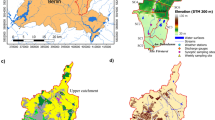Abstract
The driving actions of rainfall-runoff process can be attributed to two aspects. The first is the influence of precipitation process, and the second is that of the ground pad. The research results of 179 indoor experiments conducted to imitate rainfall-runoff process indicate that both precipitation duration and intensity play important roles in affecting confluence lag time, which is obviously inconsistent with the traditional hypotheses. The nonlinear relationship is of great significance to the confluence curve especially when the precipitation duration is less than the total confluence time or the precipitation intensity is small. Therefore it can be concluded that the unit hydrograph (UH) can be applied to rainfall-runoff process imitation in the humid areas in the south China region. However, the UH application should be strictly modified in accordance with precipitation conditions in the arid and semiarid region of north China where the precipitation duration is short and the intensity is unstable. It will be hard to get ideal imitation results if the UH is applied blindly without considering specific conditions in the north China region. This also explains the unsatisfactory imitation results caused by using various hydrological models in the north China region. When the precipitation duration is short, and the watershed has not reached total watershed concentration, the characteristics of confluence change greatly, which reflects the actual situation in the north China region. Therefore necessary nonlinear corrections should be made when UH is applied. If the duration is longer than the total confluence time and the balance between pondage and discharge is stricken, the imitation research results will be applicable to both rainfall-runoff relation with longer duration in the south China region and the basic theoretical research on runoff generation and concentration. On conditions of adequate rainfall, peak discharge is in linear relationship with intensity, but has nothing to do with the ground pad. There is a negative linear relationship between intensity and time to peak. The amount of pondage capacity in a catchment is in linear relationship with intensity and peak discharge, with obvious influence by the ground pad status and interception, and it has nothing to do with the position of interceptions
Similar content being viewed by others
References
Shen, J., Wang, W. Y., Shen, B., Experimental Study on Dynamic Hydrology (in Chinese), Xi’an: Shaanxi Science and Technology Publications, 1991, 1–5.
Eagleson, P. S., Dynamic Hydrology, New York: McGraw-Hill Book Company, 1970, 1–462.
Yang, W. Z., Shao, M. A., Peng, X. D. et al., On the relationship between environmental aridization of the Loess Plateau and soil water in loess, Science in China, Ser. D, 1999, 42(3): 240- 249.
Xia, J., Theory and Method on Nonlinear Hydrology System (in Chinese), Wuhan: Wuhan University Press, 2002, 12–25.
W. F. Rogers., A practical model for linear and nonlinear runoff, Journal of Hydrology, 1980, 46(1): 51–78.
Amorocho, J., The nonlinear prediction problems in the study of the runoff cycle, Water Resource Research, 1967, 3(3): 861–880.
Amorocho, J., Brandstetter, A., Determination of nonlinear functional response functions in rainfall-runoff process, Water Resources Research, 1971, 7(5): 1087–1101.
Diskin, M. H., Nonlinear hydrologic models, In Rainfall-runoff relationship (ed. V. P. Singh, Littleton), Colo: Water Resources Publications, 1982, 127–146.
Izzard, C. F., A mathematical model for nonlinear hydrologic systems, Journal of Geophysical Research, 1966, 71(20): 4811-4824.
Zhu X., Wen Z. R., Basic assumptions of unit graph method as checked by hydrological scale model experiments, Journal of Hydraulic Engineering (in Chinese), 1959, 3: 42–52.
Kirkby M. J., Hillsolpe Hydrology, New York: John Wiley & Sons, 1978, 1–389.
Fang X., Approach to an electrical measurement of low-discharge in the simulation experiment of rainfall-runoff, Geography Research (in Chinese), 1982, 1(2): 70–77.
Wu, K., Liu C. M., Three instruments used in rainfall-runoff simulation experiments, Hydrological Process, 1988, 2: 151–154.
Feng, Y., A study on the variable isochrone method for flood computation, Journal of Hydraulic Engineering (in Chinese), 1981, 4: 1–7.
Hua, S. Q., Wen, K., A study on the mathematical model of watershed flow concentration (I: linear model), Journal of Hydraulic Engineering (in Chinese), 1980, 5: 1–12.
Hua, S. Q., Wen, K., A study on the mathematical model of watershed flow concentration (II: nonlinear model), Journal of Hydraulic Engineering (in Chinese), 1980, 6: 1–13.
Hua, S. Q., A review on isochrone and unit hydrograph method, Water Resource and Hydropower Technology (in Chinese), 1963, 11: 10–16.
Li, J. C., Introduction to Nash’s instantaneous unit hydrograph, Water Resource and HydroPower Technology (in Chinese), 1963, 4: 18–25.
Hua, S. Q., Study on unit hydrograph, China Water Resources (in Chinese), 1957, 10: 15–21.
J. Y. Ding, Variable unit hydrograph, Journal of Hydrology, 1974, 22: 53–69.
Wen, K., Li, Q., A review of some aspects about flow concentration computations, Advances in Water Science (in Chinese), 1991, 2(1): 58–65.
Zhang, S. G., Huang, S. X., He, W. C. et al., A Study on the nonlinearity of unit hydrographs for small watersheds, Journal of Hydraulic Engineering (in Chinese), 1981, 3: 1–9.
Edited by Changjiang River Water Commission, Methodology of Hydrology Forecasting (in Chinese), Beijing: Water Resources and Hydropower Press of China, 1993, 144–145.
Vijay, P. Singh., Hydrologic Systems Rainfall-Runoff Modeling (in Chinese), Zhengzhou: Yellow River Press, 1999, 140–146.
Gill, M. A., Time lag solution of the Muskingum flood routing equation, gnNordic Hydrology, 1984, 15: 145–154.
Li, Q., Analysis and discussion related to the hydrological watershed models used in the first hydrological forecasting technology competition of China, Advances in Water Science (in Chinese), 1998, 9(2): 187–194.
Wang, J. M., Proceedings of Hydrology Information and Forecasting (in Chinese), Zhengzhou: Yellow River Press, 2000, 148–154.
Author information
Authors and Affiliations
Corresponding author
Rights and permissions
About this article
Cite this article
Zhang, S., Liu, C., Xia, J. et al. Indoor imitation experimental study on driving factors of rainfall-runoff process. Sci. China Ser. D-Earth Sci. 48, 417–428 (2005). https://doi.org/10.1007/BF02888371
Received:
Revised:
Issue Date:
DOI: https://doi.org/10.1007/BF02888371




